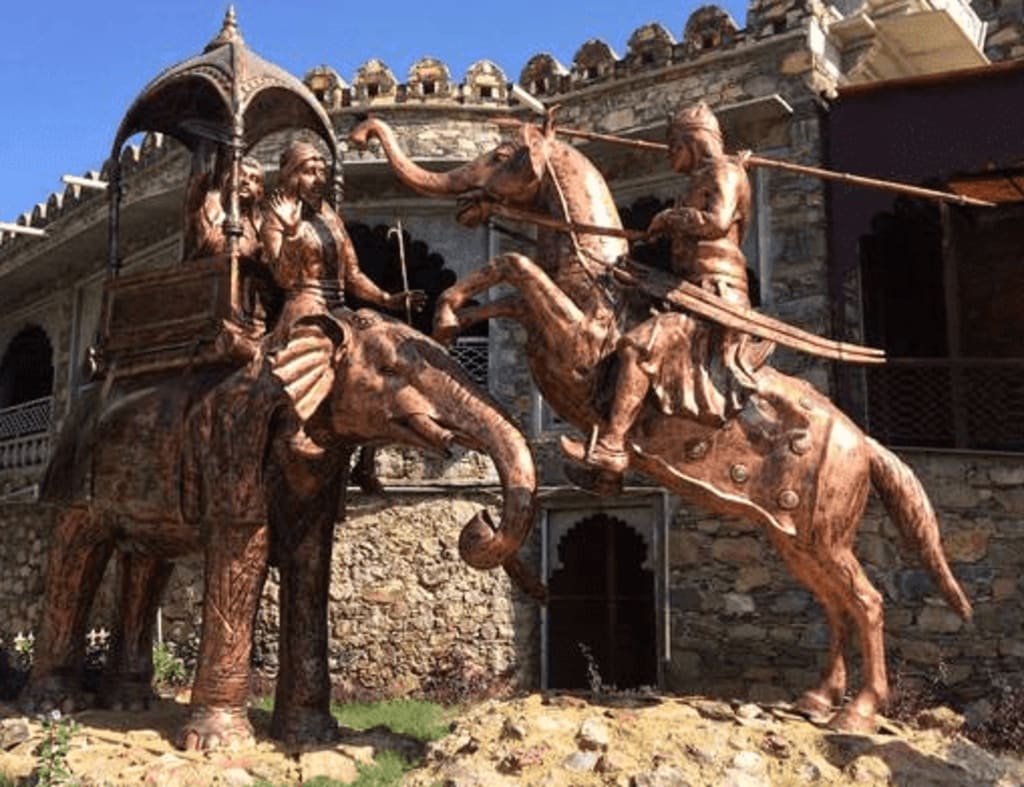Battle Of Haldighati
The Battle of Haldighati was a battle fought on 18 June 1576 between the armies of the Rana of Mewar, Maharana Pratap, and the Mughal emperor Akbar’s forces, led by Man Singh I of Amber. Although the battle ended in defeat for the forces of Mewar, Maharana Pratap escaped continuing his valiant resistance against the Mughal Empire.

Prelude To The Battle Of Haldighati
Upon his ascension to the Mughal throne, Akbar had embarked on a policy of conquest of the Rajputana region. Using a combination of diplomacy and brute force, many kingdoms of Rajputana submitted to Mughal overlordship except for Mewar.
The Rana (King) of Mewar, regarded as one of the strongest kings of the Rajput states, had fought a war with the Mughals which culminated in the Siege of Chittorgarh in 1568. The siege ended with the loss of a sizable portion of eastern Mewar to the Mughals.
When Maharana Pratap succeeded his father on the throne of Mewar, Emperor Akbar sent many diplomatic missions to convince Maharana Pratap to become a vassal of the Mughals.
The purpose behind these diplomatic missions was to both conclude the ongoing Mughal-Rajput wars and gain access to the rest of Mewar which would secure communication and supply lines to Gujarat, then a vibrant economic powerhouse of the Mughal Empire.
Four emissaries were sent to Maharana Pratap, out of these, only Raja Bhagwant Das came close to succeeding in swaying Maharana Pratap. Initially, Maharana Pratap had agreed to don a rob presented by emperor Akbar and send his young son Amar Singh to the Mughal court.
This was deemed unacceptable by the Akbar as he wanted the Maharana Pratap to submit in person. Maharana Pratap outrightly refused to do so and an additional diplomatic mission under Raja Todar Mal failed to yield any result. Thus with diplomacy having failed, the war was inevitable.
Army Strength Of The Mughals And Rajputs
Although Mewari folklore tradition has put Maharana Pratap’s forces at 20,000 facing a Mughal Army of 80,000, modern historians give a figure of 5000-10,000 for the Mughal army while putting the Mewari forces at 3000 horsemen with 400 archers from the Bhil tribes from the kingdom of Merpur. Infantry figures for the same are unknown. Both sides possessed war elephants but the Rajputs had no firearms. The Mughals possessed muskets but fielded no heavy artillery.
Rana Pratap’s estimated 800-strong van was commanded by Hakim Khan Sur with his Afghans, Bhim Singh of Dodia, and Ramdas Rathor (son of Jaimal, who defended Chittor). The right-wing was approximately 500-strong and was led by Ramshah Tanwar, the erstwhile king of Gwalior, and his three sons, accompanied by minister Bhama Shah and his brother Tarachand.
The left-wing is estimated to have fielded 400 warriors, including Bida Jhala and his clansmen of Jhala. Pratap, astride his horse, led some 1,300 soldiers in the centre. The Bhil bowmen brought up the rear.
The Mughals placed a contingent of 85 skirmishers on the front line, led by Sayyid Hashim of Barha. They were followed by the vanguard, which comprised a complement of Kachhwa Rajputs led by Jagannath, and Central Asian Mughals led by Bakhshi Ali Asaf Khan.
A sizeable advance reserve led by Madho Singh Kachhwa came next, followed by Man Singh himself with the centre. The Mughal left wing was commanded by Mulla Qazi Khan.
Maharana Pratap decided to set up his base at the town of Gogunda near Udaipur. Around 23km north of Gogunda lay the village of Khamnor, separated from by a spur of the Aravalli Range. This range was called “Haldighati” for its rocks giving a yellowish colour that resembled turmeric (Haldi)when crushed. Maharana Pratap hoped that the narrow pass of Hadlighati would help in negating his enemies superior numbers when the battle commenced. The battle commenced three hours after sunrise on 18 June 1576.
Maharana Pratap began a frontal assault committing all of his men to catch his enemies by surprise. The initial charge of his cavalry was successful in wreaking havoc on the Mughal left wing which was forced to the relative safety of the Mughal right wing. Despite the withering assault of the Rajput forces, the right-wing held firmly to bring enough time for Madho Singh’s advance reserves to enter the fray.
Soon the hardpressed Mughal vanguard was bolstered by the arrival of Madho Singh’s forces. With their arrival, the Mughal forces began to push the Mewari forces back and the battle devolved into conventional fighting as the Mewari cavalry charge had lost its momentum.
Maharana Pratap was in the thick of the fighting at the Mewari centre slaying many of his foes, although both Rajput and Mughal chroniclers allude to a duel by him and Man Singh, modern historians point out that Maharana Pratap fought against Madho Singh instead in a duel.
To break the deadlock Maharana Pratap sent in his elephants with the Mughals doing the same. Although initially gaining the upper hand, the Mewari elephants were lost due to either death or injury of their mahouts from Mughal musketeers and archers.
The loss of the war elephants enabled the Mughals to press the Mewar forces from three sides and the tide of battle began to go against the Mewar forces. This led to many deaths of Rana’s commanders, dealing an additional blow to the army of Mewar. Maharana Pratap was surrounded soon by Mughal forces, seeing this Bida Jhala seized the royal umbrella from his commander and charged at the Mughals claiming to be the Rana himself.
This act and the valiant sacrifice of about 350 of his soldiers allowed Maharana Pratap to beat a tactical retreat along with the half of his remaining army. Rajput valour and fear of ambush among the narrow passage of the hills meant that the Mughal Army could not pursue the remainder of the Mewari forces, ensuring that Maharana Pratap would continue his valiant resistance against the Mughals in the coming years.
According to historians such as Jadunath Sarkar and contemporary writers such as Abul Fazl, Emperor Akbar’s court chronicler, the Mewari army counted 46% of its total strength, or roughly 1,600 men, among the casualties. While 150 of the Mughals met their end, with another 350 wounded while the Mewar army lost 500 men.
Last Wish Of Maharana Pratap
Maharana Pratap was lying on the bed made of grass even when he was dying as his oath of freeing Chittod was not still fulfilled. At the last moment, he took his son Amar Singh’s hand and handed over the responsibility of freeing Chittod to his son and died in peace. There is no comparison in history to his fight with a cruel emperor like Akbar. When almost the whole of Rajasthan was under the control of the Mughal Emperor Akbar, Maharana Pratap fought for 12 years to save Mewar. Akbar tried various means to defeat Maharana but he remained unbeatable till the end. Besides, he also freed a large portion of land in Rajasthan from the Mughals. He underwent so much hardship but he preserved the name of his family and his Motherland from facing defeat. His life was so bright that the other name for freedom could have been ‘Maharana Pratap’. We pay tribute to his valiant memory!






Comments
There are no comments for this story
Be the first to respond and start the conversation.